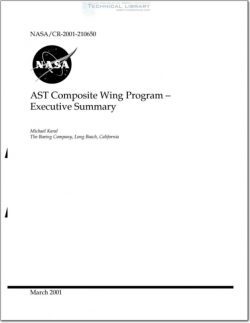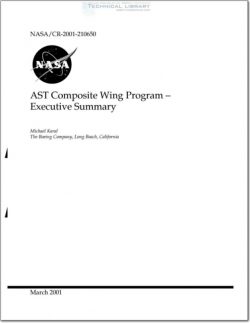NASA-CR-2001-210650

- Version
- 173 Downloads
- 10.14 MB File Size
- 1 File Count
- August 16, 2016 Create Date
- August 16, 2016 Last Updated
AST Composite Wing Program - Executive Summary

1. Introduction
Since the introduction of carbon fiber composites in the 1960’s, they have proven their merit in high
performance applications that are generally associated with military aircraft. These high performance
applications have demonstrated that primary aircraft structures made from carbon fiber composites can
achieve weight savings of 20% to 30% over similarly designed metal structures. However, this level of
weight saving and improved performance was only realized by accepting a significant cost penalty for the
enhanced composite structure. Future advanced commercial aircraft applications will place a high
priority on developing cost effective designs, and improved performance will rarely be accepted as
justification for a higher cost composite structural component. The realization of this situation has put
pressure on governmental research agencies and aircraft manufacturers to fund various efforts that strive
to lower constituent material costs and developing cost effective manufacturing processes for composite
structures.
Part of this research effort to develop cost effective composite manufacturing processes includes the
NASA Airframe Materials and Structures element of the Advanced Subsonic Technology (AST)
program, which grew out of the Advanced Composite Technology (ACT) program. The latter ACT
program was initiated in 1989, and its composite research results identified both manufacturing cost and
damage tolerance barriers to the application of these materials in commercial transport primary structures.
This long-term government and industry development effort is continuing to show positive results, and
the Boeing Company is participating in the AST program through the development of stitched/resin film
infusion (S/RFI) technology under NASA Langley contract NASl-20546.
Various types of textile composites have been evaluated for their ability to provide low cost composite
structures. Through-the-thickness stitching of dry preforms, combined with resin infusion, showed a
good potential for overcoming cost and damage tolerance issues related to using carbon fiber composites
in primary structures of commercial aircraft. Stitching through dry fabric made it possible to incorporate
various elements of a wing torque box (i.e., wing skin, stiffeners, intercostal clips, and spar caps) into an
integral structure that eliminates the requirement for thousands of mechanical fasteners. Replacing
mechanical fasteners with a highly automated stitching process has the potential of significantly reducing
manufacturing costs of composite structures. This advance in composite structure fabrication is a positive
indication that progress is continuing to be made toward reaching the long desired affordability goals for
these materials, while retaining their weight advantage over metallic designs.
In the 1980’s, toughened resin systems began to show promise for improving the damage tolerance of
carbon fiber composites, but the high cost of these new resin systems detracted from their damage
tolerance benefits. Development of through-the-thickness stitching of dry preforms was viewed as a low
cost alternative to toughened resin systems in the previous ACT program efforts. Combining less
expensive brittle resins with through-the-thickness stitching offered improved damage tolerant composite
structures at an affordable cost.
AST program element goals included making composite wing structures 25 percent lighter, reducing
fabrication costs by 20 percent, and reducing airline operating costs by 4 percent as compared to current
aluminum wing designs. These goals were shown to be achievable by the NASA/Boeing AST Composite
Wing Program (NASl-20546). These achievements are documented and discussed in this executive
summary of the AST Composite Wing Program. This report describes a weight trade study utilizing a
wing torque box design applicable to a 220-passenger commercial aircraft and was used to verify the
weight savings a S/RFI structure would offer compared to an identical aluminum wing box design. This
trade study was performed in the AST Composite Wing program, and the overall weight savings for the
composite box are reported relative to the aluminum baseline. Previous program work involved the design
of a S/RFI baseline wing box structural test component and its associated testing hardware. This detail
structural design effort which is known as the “semi-span” in this report, was completed under a previous
NASA contract. (ref. NASl- 18862)
The full-scale wing design was based on a configuration for a MD-90-4OX airplane, and the objective of
this structural test component was to demonstrate the maturity of the S/RFI technology through the
evaluation of a full-scale wing box/fuselage section structural test. However, scope reductions in the AST
Composite Wing Program prevented the fabrication and evaluation of this wing box structure. Results
obtained from the weight trade study and the full-scale test component design effort will be discussed
herein.
2. Full-Scale Stitched/Resin Film Infused Wing
2.1 Baseline Concept Description
This section of the summary addresses the airplane configuration assumptions and wing design
requirements used to define the baseline wing test component. The configuration used for the study was
the MD-90-4OX airplane, which would be representative of a tail-mounted engine design. Loads data and
systems analyses were performed by the Twin-Jet commercial design division of the Douglas Products
Group (DPG) in Long Beach. All of the structural analysis studies were performed by the Phantom
Works Divisions located in Long Beach and St. Louis.
| File | Action |
|---|---|
| NASA-CR-2001-210650 AST Composite Wing Program - Executive Summary.pdf | Download |

Comment On This Post